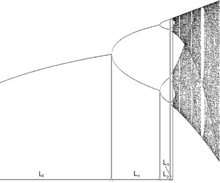Feigenbaum constants

In mathematics, specifically bifurcation theory, the Feigenbaum constants are two mathematical constants which both express ratios in a bifurcation diagram for a non-linear map. They are named after the mathematician Mitchell Feigenbaum.
History
Feigenbaum originally related the first constant to the period-doubling bifurcations in the logistic map, but also showed it to hold for all one-dimensional maps with a single quadratic maximum. As a consequence of this generality, every chaotic system that corresponds to this description will bifurcate at the same rate. It was discovered in 1978.[1]
The first constant
The first Feigenbaum constant is the limiting ratio of each bifurcation interval to the next between every period doubling, of a one-parameter map
where f(x) is a function parameterized by the bifurcation parameter a.
where an are discrete values of a at the n-th period doubling.
Here is this number to 30 decimal places (sequence A006890 in the OEIS): δ = 4.669201609102990671853203821578…
Illustration
Non-linear maps
To see how this number arises, consider the real one-parameter map
Here a is the bifurcation parameter, x is the variable. The values of a for which the period doubles (e.g. the largest value for a with no period-2 orbit, or the largest a with no period-4 orbit), are a1, a2 etc. These are tabulated below:[3]
n Period Bifurcation parameter (an) Ratio an−1 − an−2/an − an−1 1 2 0.75 — 2 4 1.25 — 3 8 1.3680989 4.2337 4 16 1.3940462 4.5515 5 32 1.3996312 4.6458 6 64 1.4008286 4.6639 7 128 1.4010853 4.6682 8 256 1.4011402 4.6689
The ratio in the last column converges to the first Feigenbaum constant. The same number arises for the logistic map
with real parameter a and variable x. Tabulating the bifurcation values again:[4]
n Period Bifurcation parameter (an) Ratio an−1 − an−2/an − an−1 1 2 3 — 2 4 3.4494897 — 3 8 3.5440903 4.7514 4 16 3.5644073 4.6562 5 32 3.5687594 4.6683 6 64 3.5696916 4.6686 7 128 3.5698913 4.6680 8 256 3.5699340 4.6768
Fractals

In the case of the Mandelbrot set for complex quadratic polynomial
the Feigenbaum constant is the ratio between the diameters of successive circles on the real axis in the complex plane (see animation on the right).
n Period = 2n Bifurcation parameter (cn) Ratio 1 2 −0.75 — 2 4 −1.25 — 3 8 −1.3680989 4.2337 4 16 −1.3940462 4.5515 5 32 −1.3996312 4.6458 6 64 −1.4008287 4.6639 7 128 −1.4010853 4.6682 8 256 −1.4011402 4.6689 9 512 −1.401151982029 10 1024 −1.401154502237 ∞ −1.4011551890…
Bifurcation parameter is a root point of period-2n component. This series converges to the Feigenbaum point c = −1.401155...... The ratio in the last column converges to the first Feigenbaum constant.
Other maps also reproduce this ratio, in this sense the Feigenbaum constant in bifurcation theory is analogous to π in geometry and e in calculus.
The second constant
The second Feigenbaum constant (sequence A006891 in the OEIS),
- α = 2.502907875095892822283902873218…,
is the ratio between the width of a tine and the width of one of its two subtines (except the tine closest to the fold). A negative sign is applied to α when the ratio between the lower subtine and the width of the tine is measured.[5]
These numbers apply to a large class of dynamical systems (for example, dripping faucets to population growth).[5]
Properties
Both numbers are believed to be transcendental, although they have not been proven to be so.[6]
The first proof of the universality of the Feigenbaum constants carried out by Lanford[7] (with a small correction by Eckmann and Wittwer,[8]) was computer-assisted. Over the years, non-numerical methods were discovered for different parts of the proof, aiding Lyubich in producing the first complete non-numerical proof.[9]
See also
Notes
- ↑ Chaos: An Introduction to Dynamical Systems, K.T. Alligood, T.D. Sauer, J.A. Yorke, Textbooks in mathematical sciences ,Springer, 1996, ISBN 978-0-38794-677-1
- ↑ Non-Linear Ordinary Differential Equations: Introduction for Scientists and Engineers (4th Edition), D. W. Jordan, P. Smith, Oxford University Press, 2007, ISBN 978-0-19-920825-8.
- ↑ Alligood, p. 503.
- ↑ Alligood, p. 504.
- 1 2 Nonlinear Dynamics and Chaos, Steven H. Strogatz, Studies in Nonlinearity ,Perseus Books Publishing, 1994, ISBN 978-0-7382-0453-6
- ↑ Briggs, Keith (1997). Feigenbaum scaling in discrete dynamical systems (PDF) (PhD thesis). University of Melbourne.
- ↑ Lanford III, Oscar (1982). "A computer-assisted proof of the Feigenbaum conjectures". Bull. Amer. Math. Soc. 6 (3): 427–434. doi:10.1090/S0273-0979-1982-15008-X.
- ↑ Eckmann, J. P.; Wittwer, P. (1987). "A complete proof of the Feigenbaum conjectures". Journal of Statistical Physics. 46 (3–4): 455. Bibcode:1987JSP....46..455E. doi:10.1007/BF01013368.
- ↑ Lyubich, Mikhail (1999). "Feigenbaum-Coullet-Tresser universality and Milnor's Hairiness Conjecture". Annals of Mathematics. 149 (2): 319–420. arXiv:math/9903201v1. doi:10.2307/120968.
References
- Alligood, Kathleen T., Tim D. Sauer, James A. Yorke, Chaos: An Introduction to Dynamical Systems, Textbooks in mathematical sciences Springer, 1996, ISBN 978-0-38794-677-1
- Briggs, Keith (July 1991). "A Precise Calculation of the Feigenbaum Constants" (PDF). Mathematics of Computation. American Mathematical Society. 57 (195): 435–439. Bibcode:1991MaCom..57..435B. doi:10.1090/S0025-5718-1991-1079009-6.
- Briggs, Keith (1997). Feigenbaum scaling in discrete dynamical systems (PDF) (PhD thesis). University of Melbourne.
- Broadhurst, David (22 March 1999). "Feigenbaum constants to 1018 decimal places".
External links
- Feigenbaum Constant – from Wolfram MathWorld
- OEIS sequence A006890 (Decimal expansion of Feigenbaum bifurcation velocity)
- OEIS sequence A006891 (Decimal expansion of Feigenbaum reduction parameter)
- OEIS sequence A094078 (Decimal expansion of Pi + arctan(e^Pi))
- Feigenbaum constant – PlanetMath
- Moriarty, Philip; Bowley, Roger (2009). "δ – Feigenbaum Constant". Sixty Symbols. Brady Haran for the University of Nottingham.

